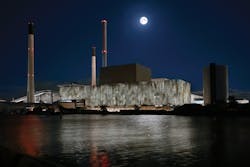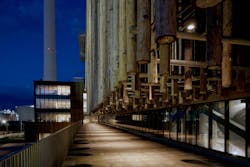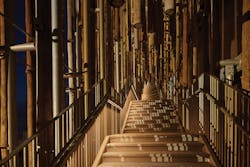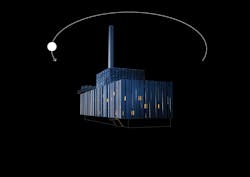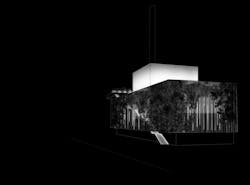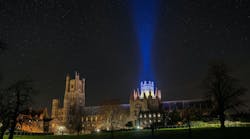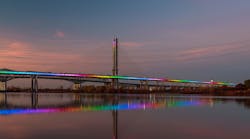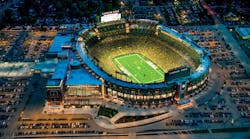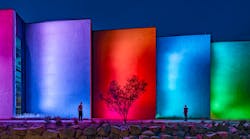The Challenge
The Amagerværket power plant, now identified as B104, is an important element in the city of Copenhagen’s efforts to become the world’s first carbon-neutral capital by 2025. The new biomass-fired, woodburning unit, an addition to the existing power plant, combines architecture and light to represent the city’s positive transition to sustainable energy. Completed in October 2021, this project is part of a vision by the city to not only provide sustainable heating, but also set an example to others and draw attention to the issues of energy production, consumption, and sustainability.
Originally built in 1971, this project welcomes the addition of a biomass-fueled combined heat and power (CHP) unit. One key objective of its architectural design—depict the changeover from fossil fuels to renewable energy that was occurring.
The Solution
Gottlieb Paludan Architects designed the renovation of the 135,000-sq.-ft. structure with a façade that prominently featured the trunks of mature local trees. Speirs Major designed the lighting— an automated program that echoes the color and movement of sunlight. The result of this collaboration: a power plant façade that resembles a luminous forest.
Through a luminous forest
According to Jesper Gottlieb, creative director and partner in Gottlieb Paludan Architects, the architectural vision was based on the theme of the forest as a place and a source of CO2-neutral biofuel. “We developed the forest theme for the façade by utilizing tree trunks, creating aesthetic and spatial experiences for both far and near perspectives. The forest theme is further developed in the master plan, where native plant species create a green and luxuriant environment surrounding the CHP plant,” explains Gottlieb.
“The façade behind the debarked trunks is clad in gold-colored metal sheets which reinforce the natural glow of the forest,” says Gottlieb. “The top of the boiler house which is visible above the trunk façade is covered in golden-colored cassettes which reflect the light, a new distinct element on the Copenhagen skyline,” he points out.
The dynamic lighting of the 20-ft. deep façade plays an important role in engaging the community and helping to embed the building into the psyche and identity of Copenhagen. By day, natural light creates beautiful shadow play through the trunks of the trees. The organic wooden cladding system helps to soften the lines of the vast building, adding nuance and texture. As darkness falls, layers of projected light shift in speed, focus and intensity, casting patterns of light and shadow that do not appear the same way twice. After dark, Speirs Major designed the visual image to be strong yet subtle, managing the light intensity to ensure that the building would integrate within the city context. The projected light reveals the depth and texture in the façade.
Although the 20-ft. thick “forest” appears only on the main façade, the single skin of trunks that clad the east and west façades is also illuminated. The façade appears in tones of warm white under normal circumstances, with a limited palette of special colors for special and civic occasions provided to boost community engagement further.
“The experience of moving within this remarkable façade after dark is something very special,” Speirs Major Senior Partner Keith Bradshaw commented. “The warm, soft, rippling light appears as sunlight filtering through trees. The external appearance of the façade also has an unusual appealing warmth and softness. It’s rare these days to see an animated façade that is not created by LED pixels, but part of the success of this project lies in our decision to use a contemporary LED source and digital control together with traditional theatrical projection techniques.
“We used filters, lenses and gobos and motorized animation disks, positioning, focusing, and controlling the speed of the light in different ways to shape an organic feel, with no sharp edges,” Bradshaw indicated. “We worked through hundreds of tests and iterations to deliver this project, beginning with models in the studio and progressing to full-size partial mock-ups before the final install and commissioning.
“Getting the color of the light right also required a great deal of effort. We studied the effects of light on timber intensively, tuning the effect to bring out the warm tones, and taking into consideration the way the wood would silver with age,” Bradshaw noted.
A staircase leading to a viewing platform cuts through the main façade of the power plant. Ascending the stairs, the experience is described by architect Gottlieb “like moving through a luminous forest.”
Deep dive into the lighting plan
To achieve the lighting design, Speirs Major used 49 Martin Professional Exterior 1000 projectors, alongside 150 DALI controlled lights for downlighting, and linear stair handrails from iGuzzini, Stoane Lighting, LightGraphix, and Vexica. “The lighting is warm white light with a very slight tint towards amber, providing a very warm natural resolution onto the timber façade posts,” says Bradshaw.
Pharos Architectural Controls is the core of the lighting control system. The LPC 2 (Lighting Playback Controller) features 1,024 channels DMX/eDMX. It allows for preprogrammed lighting effects with the freedom of real-time manual overrides. Pharos controls offer modes that can align with calendar events or special occasions. The LPC 2 works in conjunction with the Touch Panel Screen, (TPS), available in a range of different colored bezels and overlays.
Four RIO D (Remote Input Output DALI) devices provide a convenient and scalable way to control the DALI fixtures used in the BIO4 project. Single Power-over-Ethernet (PoE) network connection is a standard feature.
The effect on the façade is delivered from the front by the marine-grade theatrical projectors, which house a combination of filters, lenses, gobos, and motorized animation disks. Each is positioned, focused, and controlled in different ways. Bradshaw explains the effect is created by rotation within the projectors moving in opposite directions. “With careful adjustment of the focus and a slight tint to the light, it created a sense of direction and also the sense that the light is never repeating. Overlaid across the entire façade from the multiple fixtures and angles, we began to create the illusion of natural light, which is never the same twice. Manipulating the light to find the moment where the artificial light created this evocative nature-inspired effect took a long time, but intuitively we knew when it had been achieved,” Bradshaw says.
Stairway to sustainability
Visitors are invited to move through the forest of tree trunks via a spectacular staircase, from which a glimpse may be caught of the sustainable energy production. The stairs lead to a viewing platform rich in plants, which also works as an information platform, where visitors can learn more about energy consumption and production as well as sustainability.
“In this way, we have created a three-dimensional story that the public can actually enter, a story about the forest and about the transition to sustainable energy,” affirms Gottlieb.
This article appeared in the November 2022 issue of Architectural SSL magazine.
Project credits
- Project: B104 Power Plant, Copenhagen, Denmark
- Client: HOFOR
- Architect: Gottlieb Paludan
- Lighting design: Speirs Major
- Systems integration: Speirs Major
- Systems delivery partner: Stouenborg ApS
- Landscape: Møller & Grønborg
- Exterior Projectors: Martin
- Suppliers: Lite Nordic
- Lamps: iGuzzini, Stoane Lighting, LightGraphix, Vexica
- Photography: ©Allan Toft, courtesy of Speirs Major
Products
- Exterior Projection 1000, Martin Professional
- Linear Stair Handrails, iGuzzini
- Stoane Lighting
- LightGraphix
- LPC 2 (Lighting Playback Controller) / Touch Panel Screen, Pharos Architectural Controls
